Did You Know?
That there are two main approaches when creating an annual audit plan in BarnOwl:
- Create high level Audit Projects in advance with future start dates enabling you to generate an audit plan for the year ahead.
- Create an overarching annual Audit Plan/s against which individual Audit Projects are created. Audit Plans are particularly useful when you have a complex audit universe (multiple processes and business units) with a large-scale audit team with many hours (resources) which need to be allocated efficiently across your audit universe.
1. Create audit projects in advance with skeleton information
Step 1.1 Create an Audit Project
Capturing Audit Projects in advance with future start dates enables you to generate an audit plan. During the planning phase, for each audit project you only have to capture salient information such as the project title (name), type of project, future start date and end date and which units and processes to include in the audit project.
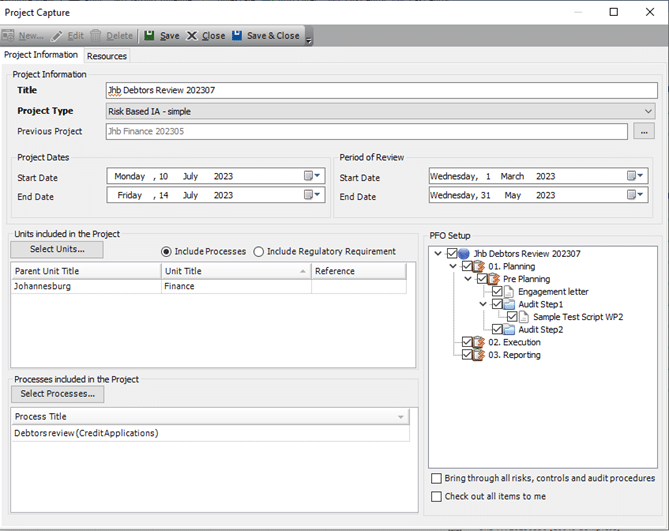
When creating an audit project with future dates, it is not advisable to tick the ‘Bring through all risks, controls and audit procedures’ and it is also not advisable to tick ‘Check out all items to me’. These activities are best done at the time of initiating (starting) the audit project (via the ‘audit content’ button within the audit project) so that the latest up to date risk and control registers are ‘imported’ into the audit project; however, if you do tick these options at the time of planning, it is still possible to refresh the risks, controls and audit procedures.
Step 1.2 Assign audit resources:
Assign audit resources (auditors) who will be working on this audit. In addition, in the ‘Project Resource Allocation’ pane, you can capture planned hours per audit task per resource in advance or when you start the project.

2. Using BarnOwl’s Audit Plan functionality
BarnOwl provides Audit Planning functionality which is particularly useful when you have a complex audit universe (multiple processes and business units) with a large-scale audit team with many hours (resources) which need to be allocated efficiently across your audit universe.
Step 2.1: Set the maximum available audit hours:
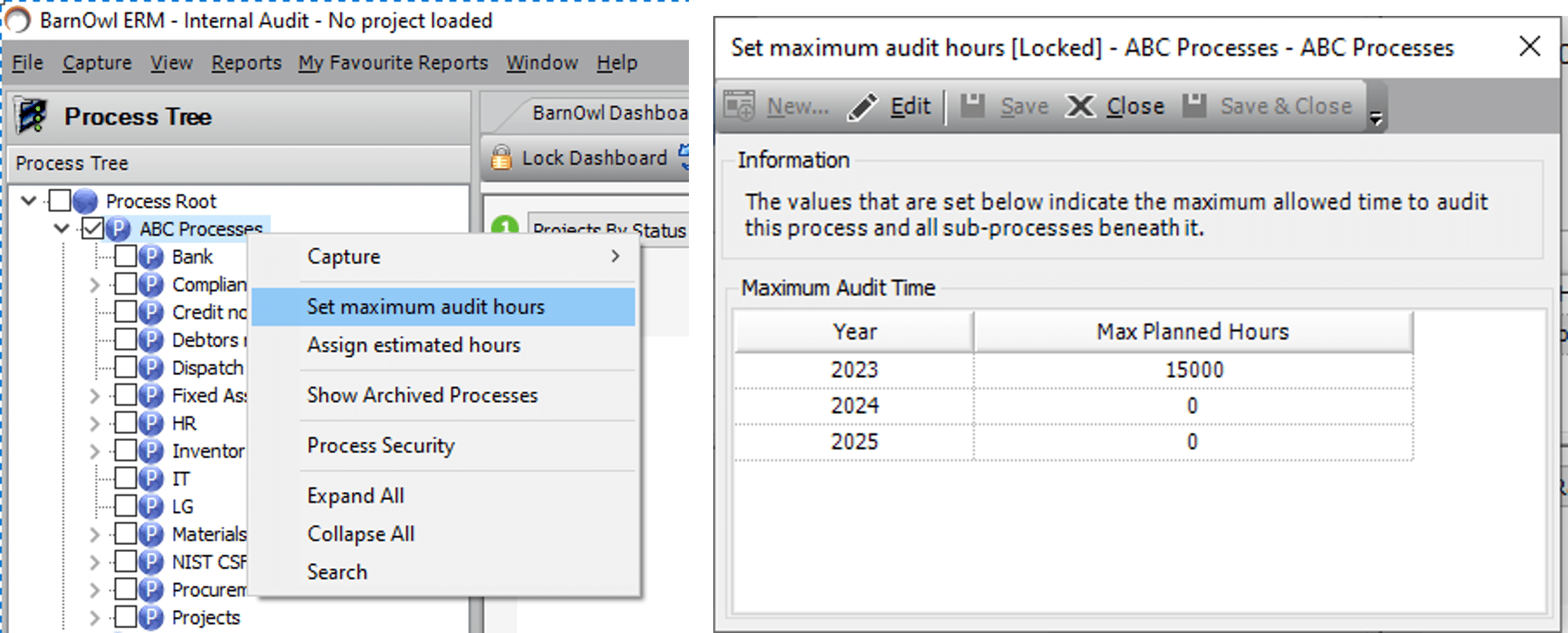
In the example above we have set the maximum hours to 15,000. Assuming about 250 working days per resource x 8 hours (2,000 hours per resource) we have a team of +- 8 auditors.
Step 2.2: Assign estimated audit hours per process:
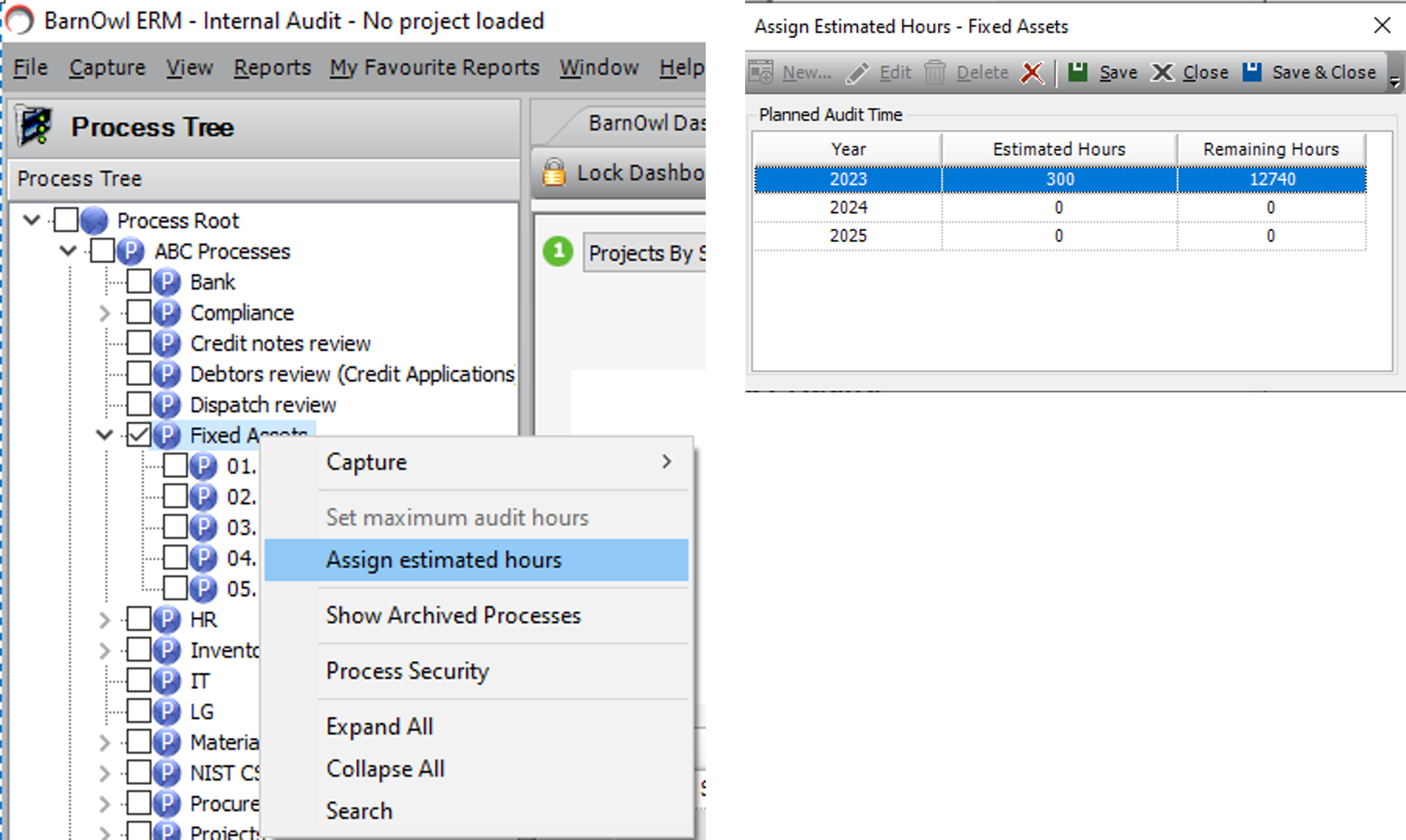
In the example above, 300 hours have been allocated to audit the ‘Fixed Assets’ process showing ‘Remaining Hours’ of 12,740 out of 15,000 hours, after taking into account the hours allocated to this process (Fixed Assets) and other processes.
Step 2.3: Create an Audit Plan/s:
You can create one or many Audit Plans:

Capture the Audit Plan Title (name), the Start Date and End Date (e.g. annual plan) as well as select the Project Type (configured in SMC (Server Management Console)) which determines the PFO (Project File Organiser) structure for each type of project (e.g. Risk & Control based, Ad hoc, Forensic, etc.).
Select which processes to include in the Audit Plan and select which units (organisational structure) to include in the Audit Plan. Only units where the selected processes exist (have been applied previously) can be selected:
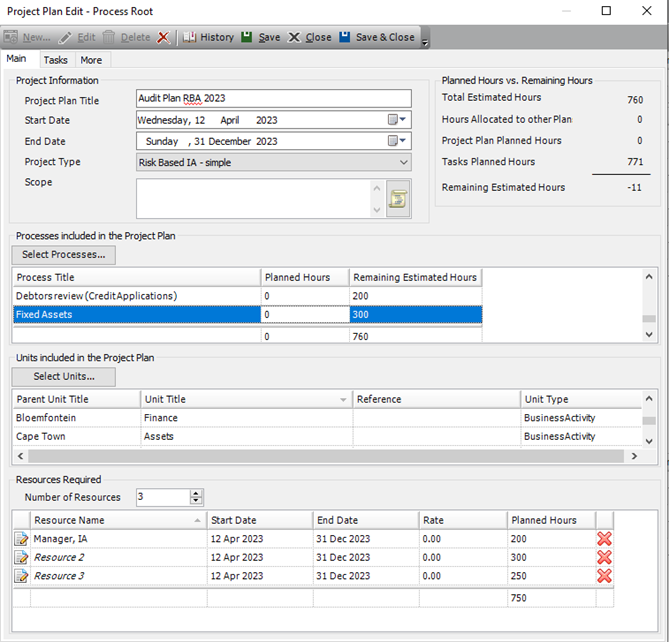
- Total Estimated Hours (760 hours): the system automatically shows you the sum of the ‘Estimated Hours’ for all the selected processes in this audit plan which are displayed in the ‘Processes included in the Audit Plan’, ‘Remaining Estimated Hours’ field. The hours per process were captured in Step 2.2 above.
- Hours Allocated to Other Plan: any hours that have been allocated to another Audit Plan.
- Project Plan Planned Hours: the total of the ‘Planned Hours’ in the ‘Processes included in the Audit Plan’. In this example however, zero hours have been captured in ‘Planned Hours’, as we have chosen to rather capture the planned hours at a more granular level of tasks per business unit. See Step 2.4 below.
- Tasks Planned Hours (771): the planned hours we have captured against tasks per business unit (see Step 2.4).
In the second half of the form above, you will find panes for:
- Processes included in the Audit Plan: Select the processes to include in this Audit Plan showing ‘Remaining Estimated Hours’ (as setup in Step 2.2 above) and capture ‘Planned Hours’ per process if required.
- Units included in the Audit Plan: Select the units to include in this Audit Plan. Only units where the selected processes exist (have been applied in ERM) can be selected.
- Resources Required: This enables you to estimate how many resources and time required per resource to meet the Audit Plan’s estimated hours. It is possible to assign the actual resources (auditors by name), however, given a large audit team, this is often not practical during the planning stage. The system defaults to the number of available hours per resource between the start and end dates.
Step 2.4: Capture planned hours per task in the Audit Plan:
This step is optional and allows planned hours to be captured per task (tasks are determined by the project type) per business unit. The advantage of this step is that at a later stage, when Audit Projects are captured against this Audit Plan, the system maintains a running total of the planned hours remaining per task per business unit (see Step 2.6).
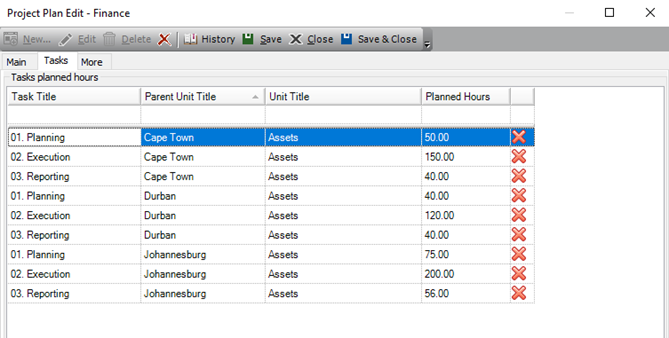
The total hours = 771 which are shown in ‘Tasks Planned Hours’ (step 2.3 above).
Step 2.5: Create an Audit Project from an Audit Plan:
View>Project Plan Register
Click on the relevant Audit Plan to create an Audit Project from the Audit Plan:

The system automatically copies the default Audit Plan information into the Audit Project. Edit the Audit Project fields (indicated in red below) and select the specific business units you wish to audit in this Audit Project:

The screen below shows an example of the changes we have made to the Title (CT Dispatch Review 202308), the Start and End Dates, Period of Review Dates and selecting a specific business unit (i.e. Cape Town>Finance)’:
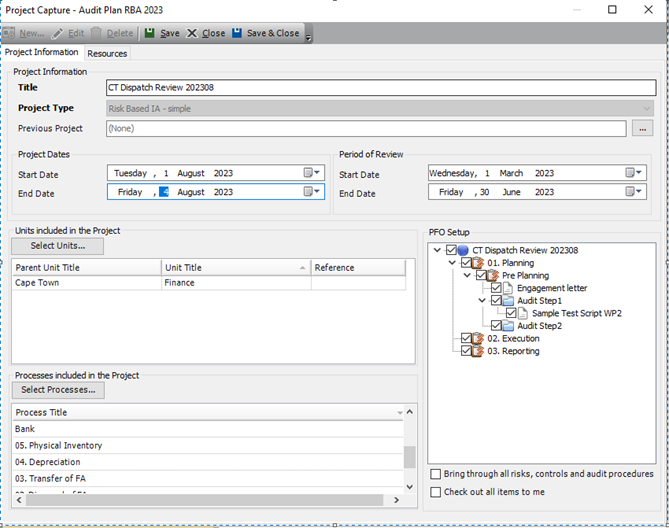
On creation (saving) of the Audit Project, the system automatically removes any processes which are not applicable to the unit (in this case Cape Town>Finance) you have selected:

The Audit Project ‘CT Dispatch Review 202308’ is created and the relevant risks, controls and audit procedures are imported from the risk library:

Step 2.6 Allocating hours in the Audit Project
When allocating planned hours per task per resource in the Audit Project, the system displays the sum of ‘Planned Hours’ across multiple projects and the ‘Remaining Hours’ (see red highlights below) calculated from the Audit Plan (captured in step 2.4):

This helps you manage the remaining time available across multiple audit projects taking into account the total time you allocated in your audit plan.
Step 2.7 Viewing the Audit Plan Register:
The screen below shows the Audit Plan ‘Audit Plan RBA 2023’, expanded to show the linked Audit Projects and their various stages of completion:
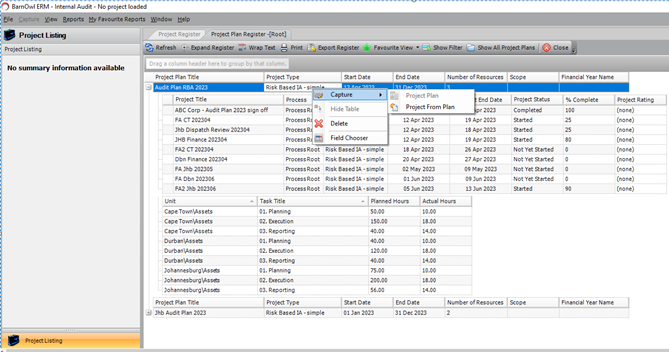
The bottom pane (in the form above) shows the Unit, Task and Planned Hours for this Audit Plan as well as the sum of ‘Actual Hours’ across all Audit Projects in the Audit Plan. Actual hours are captured by the auditors within each project and / or via BarnOwl’s timesheet and expense capture function.
3. View your Audit Plans and Audit Projects
BarnOwl provides numerous registers and reporting options to view your audit plan and audit projects.
Fig 3.1 View>Project Register
This register shows all Audit Projects with their salient information. As with all BarnOwl registers, fields can be filtered, sorted, grouped, hidden, added as well as the ability to save favourite views and share favourite views. In addition, registers can be expanded to show child tables as well as grouped by child tables. The following view shows all audit projects sorted by start date in descending order. The ‘Project Plan’ field (column) indicates which projects have been created from an Audit Plan:

Fig 3.2 View>Project Plan Register
This register shows all project plans with their associated audit projects. The bottom pane shows which units have been selected on this plan and the planned hours and actual hours per unit per task:
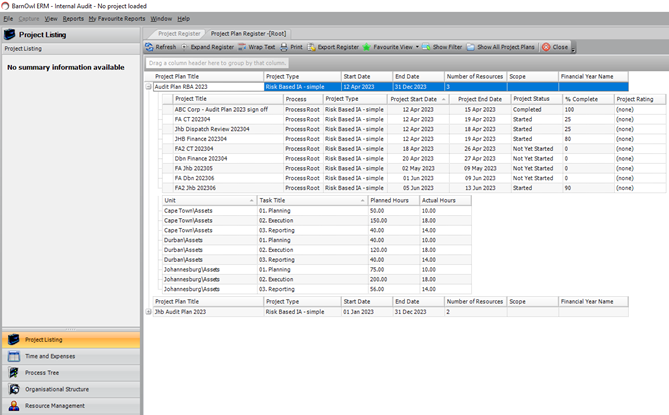
Fig 3.1 View>Project Plan Timeline
By selecting the relevant business units and / or process units, you can view a Gantt chart of Audit Plans and Audit Projects. The Gantt chart below shows an Audit Plan ‘Audit Plan RBA 2023’ (dark blue bar) with its associated Audit Projects below it (dark green bars) showing the % complete of each Audit Project.
In addition, the Gantt chart shows the Audit Projects (light blue bars) which were created as stand-alone audit projects and not from an Audit Plan.
Double click on any Plan or Project to open the associated Audit Plan and / or Audit Project.
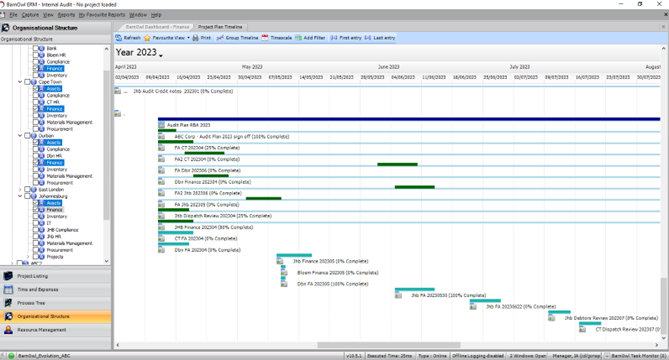
You can find more information on the BarnOwl audit registers at: https://barnowl.co.za/knowledge-base/tip-of-the-month/the-power-of-barnowl-audit-registers/
In summary
- BarnOwl supports audit planning using a combination of Audit Plans and / or future dated Audit Projects.
- Future dated Audit Projects is a simple way to create an annual audit plan.
- Audit Plans are particularly useful when you have a complex audit universe (multiple processes and business units) with a large-scale audit team with many hours (resources) which need to be allocated efficiently across your audit universe.
- BarnOwl assists you with resource planning including time sheet and expense management.
- BarnOwl provides numerous registers and reporting options to view your audit plan/s and audit projects.
- BarnOwl audit is fully integrated with risk management supporting best practice risk and control based auditing.
- BarnOwl version 11 includes standard Power BI dashboards (for risk, compliance and audit) at no additional cost. The BarnOwl standard Power BI dashboards can also be customised to meet client specific requirements on a quotation basis. http://api.barnowl.co.za/wp-content/uploads/2023/05/BarnOwl-V11.1-Spotlight-20230525-1.pdf
Useful links
https://barnowl.co.za/knowledge-base/tip-of-the-month/the-power-of-barnowl-audit-registers/
https://barnowl.co.za/knowledge-base/tip-of-the-month/barnowl-combined-assurance/
http://api.barnowl.co.za/wp-content/uploads/2023/03/Overview-of-BarnOwl-Audit-Process-v2.pdf
About BarnOwl:
BarnOwl is a fully integrated governance, risk management, compliance and audit software solution used by over 150 organisations locally and internationally. BarnOwl is a locally developed software solution and is the preferred risk management solution for the South African public sector supporting the National Treasury risk framework.
Please see https://api.barnowl.co.za for more information.